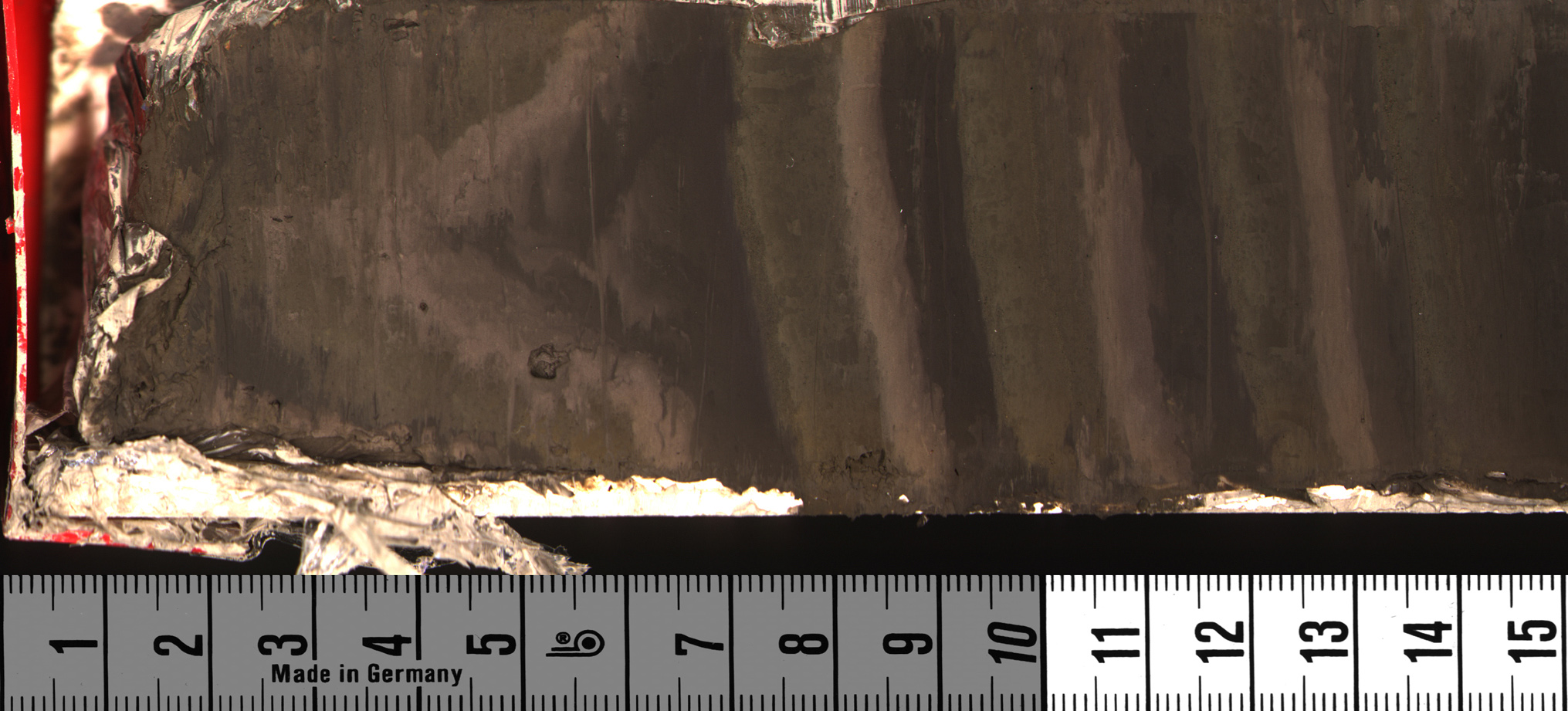
Extreme ‘biscuiting’ in a core penetrating indurated Plio-Pleistocene lacustrine sediment. A matrix of injected drilling mud (light grey) supports disconnected wafers of internally coherent sediment. Individual wafers are rotated up to ~30º in the z dimension, and have unknown orientation in the x-y plane. Similar features may be present but far less obvious, depending on the character of the cored material. Core ID: HSPDP-NAW14-1A-81Q-1
Tags: lithified tilting rotation brittle biscuiting disking discing diamond-rotary wafers rotary-drilling Device:rotary




Pervasive homogenization of the upper 90 cm of a core penetrating weakly lithified Pleistocene lacustrine sediment collected using rotary drilling tools and drilling mud. Voids are also interpreted as artifacts. Matrix-supported blocks of intact sediment are apparent from 60-80 cm. Core ID: ODP-OLO12-1A-80Q-2
Tags: lithified tilting rotation homogenization brecciation matrix-suported drilling-mud rotary-drilling diamond-rotary Device:rotary




Brecciation, local homogenization, and drilling mud injection in a core penetrating weakly lithified Pleistocene volcaniclastic sediment collected using rotary drilling tools and drilling mud. Illustrating the problematic interpretation of some drilling artifacts, this drill core section is interpreted to show matrix-supported textures both as a result of drilling disturbance (0-16 cm) and as a primary depositional feature (20-50 cm). Sub-parallel, near-horizontal gray fine-grained features (49-58 cm; 76-90 cm) are continuous with annular accumulation of drilling mud, and are interpreted as injection artifacts highlighting incipient ‘biscuiting’ (differential rotation and shearing) of core material. This phenomenon may be amplified by drilling practices. Core ID: ODP-OLO12-1A-62Q-1
Tags: lithified brecciation homegenization drilling-mud matrix-supported rotary-drilling biscuiting discing disking diamond-rotary Device:rotary brittle




Rotation of an internally coherent, intact 29-cm section of lithified volcaniclastic sediment (65.5 - 94.5 cm) offsets the disturbed material an unknown amount in the x-y plane. Rotation occurred along distinct horizontal fractures. Drilling practices (discontinuous advance of the drill bit) may play a role in this style of artifact. Core ID: ODP-OLO12-1A-55Q-1
Tags: lithified rotation brittle rotary-drilling drilling-mud diamond-rotary Device:rotary




Pervasive brecciation in a core penetrating weakly lithified volcaniclastic sediment, collected using rotary drilling tools and drilling mud. Both matrix-supported (drilling mud) and clast-supported textures are present. Brecciation in this material appears to have produced a relatively uniform, 2-5 mm clast dimension, frequently angular. Core ID: ODP-OLO12-1A-67Q-2
Tags: lithified rotation brittle tilting brecciation rotary-drilling drilling-mud clast-supported matrix-supported Device:rotary




Moderate to severe apical doming with unusual bicuspid structure in a percussion core penetrating heterogeneous clastic sediment (Holocene?). Core-margin homogenization is a common feature of percussion cores. Core ID: AK-BAK06-3A-1N-2
Tags: ductile plastic doming bicuspid core-margin-homogenization Device:Nesje Device:percussion-corer




Localized drive-top suction deformation in a Livingstone core penetrating a sequence of glacial varves (late Pleistocene?). Core ID: CAB-MCF12-1A-7L-1
Tags: doming suction Device:Livingstone




Severe, pervasive apical stretching and flow deformation in a percussion core penetrating heterogeneous clastic sediment (Holocene). Core ID: ICE4-HVT08-1A-1N-2
Tags: stretching ductile plastic shearing homogenization doming flow-deformation Device:percussion-corer Device:Nesje




Minor to severe apical doming and flow deformation in a percussion core penetrating heterogeneous Holocene volcaniclastic sediment. The recumbent fold (axial plane near 110 cm) is interpreted as a slump within the sediment sequence, unrelated to coring. Core ID: ICE4-HVT08-1A-1N-4
Tags: stretching ductile plastic shearing Device:percussion-corer Device:Nesje doming flow-deformation slump fold




Extreme plastic deformation in a laminated volcaniclastic sediment (Holocene), resulting in stratigraphic rotation of the cored sediment. Core ID: ICE4-HVT08-4A-1N-1
Tags: stretching ductile plastic shearing Device:percussion-corer Device:Nesje apical-irruption




Severe to extreme apical doming and flow deformation in a laminated volcaniclastic sediment of Holocene age. Severity of deformation generally increases upward. More severe deformation amounts to near-homogenization of sediment. Core ID: ICE4-HVT08-4A-1N-2
Tags: stretching shearing plastic ductile tilting rotation Device:percussion-corer Device:Nesje apical-irruption homogenization matrix-supported




Discontinuous brecciation (with matrix support by drilling mud?) and homogenization isolating intact blocks of weakly lithified lacustrine sediment. Brecciated feature in upper 10 cm is tentatively interpreted as a natural mud crack infill with brecciated material, while core-centered features lower in the core imply coring disturbance. Core recovery used rotary tools and drilling mud. Core ID: ODP-OLO12-1A-77Q-1
Tags: lithified infill brittle Device:rotary drilling-mud mud-crack dessication-crack homogenization brecciation matrix-supported




Complex deformation in a percussion core penetrating ornately laminated and heterogeneous clastic sediment (Holocene?). Rheological contrasts and the down-section distribution of coring stresses combine to produce the complicated interplay of ductile and brittle deformation seen here. The upward increase in the severity of ductile deformation is a relatively common feature of deformed percussion cores. Effective sampling resolution may vary widely in a core such as this, especially in less structured sediment where deformation is more difficult to discern. Core ID: AK-BAK06-2A-1N-1
Tags: ductile plastic Device:percussion-corer Device:Nesje bicuspid homogenization rheology microfaulting brittle




Missing sediment sequence shown by overlapping drives of closely juxtaposed (sites within ~2 m) Livingstone piston cores. Artifacts of this nature are thought to occur most commonly in sediment sequences with strongly contrasting compressional strength and/or coefficients of friction. In JONES97 1B-6L-1, the Mazama tephra appears to have impeded underlying sediment from moving into the core barrel during some 30 cm of advance. JONES97 1A-6L-1 reveals the missing sequence (distorted), the existence of which would otherwise be impossible to discern. This feature emphasizes the value of collecting overlapping core sequences. Core ID: SHAP-JONES97-1A-6L-1 (upper) and SHAP-JONES97-1B-6L-1 (lower)
Tags: brittle ductile plastic event-deposit Device:Livingstone rheology




Normal microfaulting interpreted as seismically-triggered sediment deformation. Fault offsets diminish and end up-section and are not bounded by core margins, suggesting post-disturbance burial of the microstructures. Core ID: TDP-TOW15-2B-5H-2
Tags: brittle microfaulting fracture seismite Device:HPC Device:hydraulic-piston




Syndepositional and post-depositional deformation of laminated aragonite mud (Holocene), recovered by Livingstone piston coring. None of the features displayed in this core are interpreted as coring artifacts. Rather, slumping and ductile deformation of a weak and unstable sediment package are reflected in the complex sequence of non-planar lithologic contacts seen here. Core ID: SHAP-EVANS97-1A-7L-1
Tags: ductile plastic shearing stretching Device:Livingstone microfaulting fold slump compaction load-structure foliation rheology fold




A matrix-supported soft-sediment breccia resulting from a seismically-triggered subaqueous slump, recovered by Kullenberg piston coring. Brecciated and locally homogenized features in this sequence are not attributed to coring artifacts, but rather to subaqueous slope failure and gravity transport of discrete sediment blocks, some including lithologies exotic to the coring site. Core ID: FISH-RDF07-2A-1K-5
Tags: event-deposit brecciation matrix-supported Device:Kullenberg slump homogenization




Extreme doming and effective 90º axial rotation of sediment structure from depositional orientation in laminated volcaniclastic sediment of Holocene age, collected with a Nesje percussion coring device. The coined term ‘apical irruption’ is suggested for this full perpendicular rotation of structure. Note that whole-core geophysical features (density and magnetic anomalies) may be entirely masked by this degree of coring disturbance. Core ID: ICE4-HVT08-5A-1N-1
Tags: ductile plastic shearing stretching doming flow-deformation Device:percussion-corer Device:Nesje apical-irruption




Severe apical doming and near-homogenization of volcaniclastic sediment of Holocene age collected using a Nesje percussion-coring device. In the zone of apical doming, the highlighted coarse clastic intervals (basaltic tephras?) are deformed into overlapping stratigraphic positions that will reduce magnetic anomalies to a nearly homogenized signature in whole-core scanning, despite retaining their stratigraphic identity. Core ID: ICE4-HVT08-5A-1N-2
Tags: stretching Device:percussion-corer Device:Nesje doming homogenization




This complex and enigmatic assemblage of deformational structures is interpreted as dominantly reflecting slumping, overturned folding, and shearing of the sediment package. Basaltic tephras (highlighted) show clean core-wall boundaries and are distorted mainly along apparent slump folds (but may be locally pinched by coring at 11 cm and 70 cm). High-angle microfaults near 50 cm are truncated by low-angle zones of sediment shearing, and do not appear to be coring artifacts. Core ID: ICE4-HVT08-4B-1N-4
Tags: event-deposit Device:percussion-corer Device:Nesje fold slump microfault




The lower lithologic unit in this core (material below 125 cm) is a locally massive, matrix-supported material that in isolation could be misinterpreted as exhibiting pervasive coring disturbance. However, the unit is actually the upper gravity-transported facies of a large-scale subaqueous slump, as shown by the thick white overlying unit, which is a fining-upward ‘cap clay’ (mostly in fine the medium and fine silt range) representing the slump-generated material entrained in the water column. The irregularity of the contact between the two units is likely a coring artifact caused by the thixotropic character of the capping silt. The core is composed of Holocene-aged diatomaceous silt and was collected by a Kullenberg piston-coring device. Core ID: FISH-RDF07-1A-1K-2
Tags: event-deposit grading homogenization slump seismite Device:Kullenberg turbidite




Holocene sandy silt and silty sand recovered in a Kullenberg piston core. The lithostratigraphic unit from 45 to 120 cm appears locally massive and might be mistaken for a pervasive homogenization artifact if seen in isolation from its stratigraphic context. In fact it is an unusually thick (for lacustrine sediment) turbidite sequence produced by failure of a rapidly accumulating delta front. Look for diagnostic basal and capping textures, which would not be expected in a homogenized artifact. Note that the thickness of this event deposit would often place basal coarse material and the capping silt in different core sections. Core ID: FISH-WOW07-1A-1K-5
Tags: event-deposit grading homogenization slump seismite Device:Kullenberg turbidite




Secondary infill feature interpreted as a deep desiccation crack, recovered in a hydraulic piston core. Massive or weakly structured infill is capped by brecciated sediment and the up-section resumption of laterally continuous sediment structure. Between 110 cm and 85 cm, conformable sediment could be selectively sampled from this core, but not from the central core face. Core ID: HSPDP-CHB14-2B-4H-2
Tags: lithified infill dessication-crack mud-crack Device:hydraulic-piston Device:HPC




Differential rotation revealed by offset bedding orientations in lithified lacustrine sediment of early Pleistocene age. Injection of annular material and drilling mud occurs along joints formed or amplified by rotary drilling. Compressional deformation also attributable to drilling forces produced the conjugate faults at 138 cm. Core ID: HSPDP-WTK13-1A-68Q-2
Tags: lithified rotation brittle Device:rotary fracture drilling-mud microfaulting




Late Holocene glaciolacustrine varves recovered in a Livingstone core (upper) and in a vibracore, a high-frequency percussion core (lower). The sediment sections shown are lithologically related and from nearby sites but are not directly correlative. Sediment liquefaction under percussive vibration produced a thick but variable unstructured rind along core margins of the vibracore, as well as moderate to severe sediment doming. The up-core increase in the severity of coring artifacts is commonly observed in percussion cores. The Livingstone core demonstrates the sharpness of contacts in minimally-disturbed equivalent material. Core ID: ICEBERG-ICE01-1A-5L-1 (upper) and ICEB2-ICE10-1B-1V-6
Tags: microfaulting shearing stretching Device:vibracorer Device:vibra-corer doming homogenization Device:Livingstone




116 Church Street NE, Minneapolis, MN 55455
P: 612-626-7889